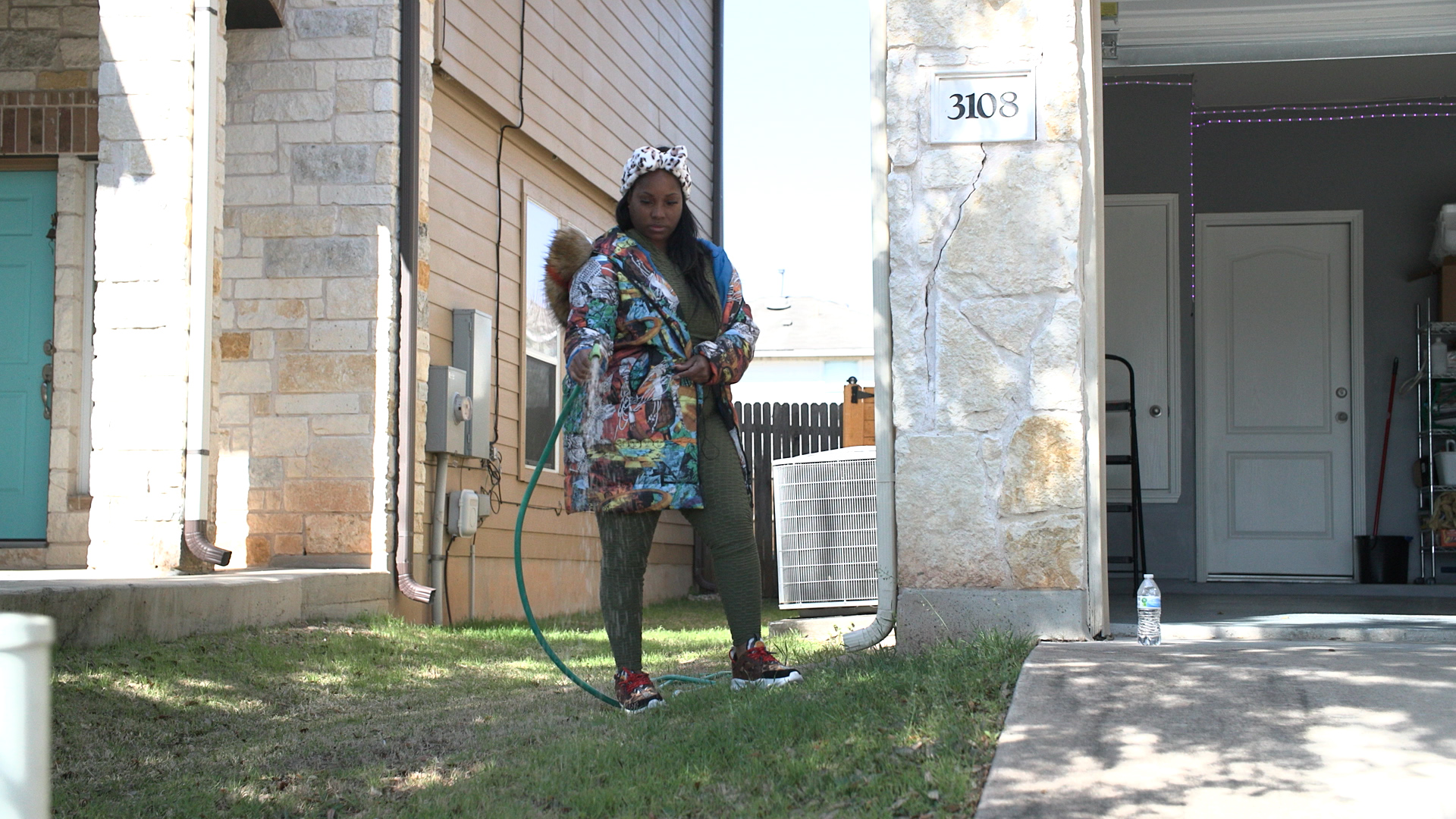Drained
When Cherelle Roberts bought her house in Austin’s Colony almost 12 years ago, she saw it as an investment that would pay off in the long run. She expected there to be some expenses but didn’t think her water bill would be one of them. Roberts was so shocked by her first water bill that, after failing to reach a representative on the phone, she headed to her neighbor’s house, bill in hand.
“I was like, ‘Hey, is this correct?’” says Roberts. “They started laughing immediately, like, ‘Yes, welcome to Austin’s Colony.’”
Austin’s Colony is a neighborhood within Austin’s extraterritorial jurisdiction but outside its municipal water service area. Unlike most homes in the City of Austin, the neighborhood receives water services from Hornsby Bend Utility, a subsidiary of SouthWest Water Company. Like many of her neighbors, Roberts is frustrated with the high cost and low quality of the water she receives from the company. But living in a municipal no-man's land has left residents with few options. They’re often left with two choices: pay up, or move.
Two water towers dot the landscape behind the Austin’s Colony neighborhood. Because the area is in an extraterritorial jurisdiction, residents have fewer options when it comes to raising concerns about water prices and quality as compared to municipal water customers.
“It's something like three or four times as much as comparable areas close by,” Roberts says.
Roberts used to live in an area serviced by Austin Water and says her bills were less expensive than they are now. Austin Water is a municipal utility, meaning it’s owned by the city. But residents in Austin’s Colony and Hornsby Bend receive water from an investor-owned utility, or IOU. IOUs tend to be more expensive on average. In Hornsby Bend and Austin's Colony, residents report water bills ranging anywhere from $150 to $300 per month. Manuel P. Teodoro, an associate professor at the University of Wisconsin-Madison who focuses on utility affordability says that’s because IOUs are out to make a profit.
“If you had two perfectly identical water systems right next to each other, one was owned by a government, one was owned by an investor-owned firm,” he says. “The investor-owned firm is going to charge 10% more because it's going to be sending a profit to its shareholders.”
Jeff McIntyre is the president of Texas Utilities for SouthWest Water Company. He says he believes water is a need that comes with a cost.
“Water is a basic human need, but so is food and you don't get either for free,” McIntyre says. “The other thing, though, is we don't sell water, we provide water service. We take water that's typically undrinkable as it is. We treat it. We test it. We make sure it's safe … what we're getting back is the cost of doing that for them.”
IOUs are not always incredibly expensive compared to municipal utilities. McIntyre says their rates just cover operating expenses – the “true cost” of providing water. However, that true cost is a base rate of $47, which is six times higher than that of Austin Water.
Teodoro says those price points usually mean IOUs can invest more money into the utility.
“Which is a good and a bad thing,” Teodoro says. “On the bad side, it means things are more expensive. On the good side, it usually means the quality is better.”
But that’s not always the case. Residents in Hornsby Bend and Austin’s Colony have long complained about issues with hard water – water with high concentrations of magnesium and calcium. While it’s unpleasant, it’s not illegal. Hornsby Bend Utility passes drinking water standards set by the Environmental Protection Agency and the Texas Commission on Environmental Quality. But hard water can wear down water infrastructure and, in Roberts' case, cause intense skin and hair irritation. Residents find themselves replacing equipment like water heaters or installing water softener systems for their homes, both of which can be pricey.
“When I went through the process of figuring out which softener system would be best, I found out it was in the thousands,” Roberts says. “I was like, ‘That's something I'm going to have to do. I'm going to have to swallow that pill.’”
Cherelle Roberts washes her face in her home. When she started noticing skin and hair issues due to the water, she tried to reach out to SouthWest Water with her concerns but had trouble reaching the company.
Maintenance of the system, on top of a water bill, is a significant monthly expense for Roberts. However, tacking on additional water costs is not within every resident’s reach in Austin’s Colony. The median income for the area is about $60,000 a year.
“If you think of the cost over the years, it's astronomical,” Roberts says. “You come across those people that just can't afford it.”
If residents in the ETJ are unhappy with the rate increase, their options are limited compared to people living within city limits. For Austin, the city council sets rates. Residents can appeal to their representative or the mayor if they’re unhappy with the increase. For residents like Roberts, there’s no elected official to reach out to with concerns because they are outside the city limits and not represented on the city council.
“I've even reached out to the mayor. I've reached out to the governor,” says Roberts. “They've heard things about us, but nothing has happened.”
The neighborhood does fall under county precincts, but residents have been told by county commissioners that they don’t get involved with utility issues. Reaching out to county representatives had been made even more difficult for residents in this area since it was recently redistricted, splitting neighbors between Precinct 1 and 4. Hornsby Bend Alliance President Tina Byram has long worked with county and U.S. representatives to highlight water access issues in the area, but the redistricting makes her feel like she’s starting at square one with new people.
“This redistricting really hurt my community,” Byram says. “To fight the water company, it just makes it harder.”
Residents can reach out to the company directly with complaints, but it can be difficult. McIntyre says the company doesn’t hold regular public meetings and has no plans to do so. Residents can reach out via a customer service line, but Roberts has found the response lacking.
“It was not [like] you could call and get straight to a human person for customer service,” she says. “It was like, ‘OK, please call back. We’re not available.’”
She’s not alone in having trouble contacting the company. A host of Yelp reviews and Facebook posts reveal customers struggling to reach the company. McIntyre says the company endeavors to respond to customers’ concerns.
“We want to solve our customers’ problems,” McIntyre says. “But when it comes to approved rates and tariffs, we're stuck with the approved rates and tariffs that the [Public Utility Commission of Texas] gives us.”
The Public Utility Commission of Texas does regulate rates, but says it doesn’t give IOUs a rate to charge. Instead, the commission has final say over a company’s proposed rates. Tammy Benter, the director of utility outreach for the PUC, says that process starts when an IOU applies to become the water provider for an area. Companies provide documentation to back their proposed rate or rate hikes, and the PUC either approves it, denies it or amends it.
“They have to go through an application process … and say, ‘Here’s what it costs in this 12 month period to run our utility,’” Benter says. “They show that so they can include it in their rate base.”
Residents can reach out to the PUC with rate concerns. But moving forward with a rate complaint requires some legwork. The PUC requires a petition with signatures from 10% of affected customers to move forward with rate complaints. Quality complaints go to another agency completely, the TCEQ. McIntyre says SouthWest Water informs customers which agencies to report issues to, but they do not pass along any complaints to the responsible agency. It’s up to residents like Roberts to push their concerns forward.
“There's always been talks with the board and the HOA to try to go against the machine,” Roberts says. “But when you have a company that's so big and then also a neighborhood that is either poor or middle class, it becomes, do we have the money to go up against the water company? And then if we do, then who do we have, who can take this over?”
Austin’s Colony resident Cherelle Roberts waters her front lawn. She’s looking into changing her lawn, adding native Texas plants in hopes of lowering her water bill.
The answer is almost no one. Some of this is due to infrastructure. A company has pipes leading to a neighborhood, and having another entity take over would require adding pipes or buying out a system, which can cost millions. The other issue according to Benter is who holds the Certificate of Convenience and Necessity.
“A CCN is basically a geographic area,” says Benter. “It gives the utility the authorization to provide retail, water and sewer service in that geographic boundary.”
It also means other utilities can’t provide services there. Some groups refer to this as “monopoly utilities” because other companies can’t come in and compete for customers. Even if a neighborhood in a city’s ETJ were annexed into the city, that city’s municipal utilities could not offer services to its new members because it would not automatically have a CCN for that area. Residents can ask a utility to submit paperwork to get a dual CCN for their area, but Benter says those are uncommon.
“There's criteria they would have to meet in order to get dual certification,” Benter says. “It's not just granted all the time.”
With few political or capital options, most residents are simply left footing the bill. Byram says the area is looking into different options, like forming a Municipal Utility District or a Municipal Management District, that would give them more leverage with SouthWest Water Company. But she admits it's been difficult to rally residents after a failed attempt to incorporate into their own municipality nearly 10 years ago. A substantial monthslong effort by the community ended at Austin City Hall, where residents cited, among other things, water quality issues as reasons they need to be their own township. It was voted down.
“Everyone got discouraged,” Byram says.
In the meantime Roberts does what she can to keep her bills low. She’s looking into replacing her lawn with drought-resistant natural plants and crushed rock. But she knows these are only stop gap measures.
“Drinking water is a necessity,” Roberts says. “This isn’t something you can price gouge us on.”
Update 3/31/2022: This story was updated with quotes from Jeff McIntyre, president of Texas Utilities for SouthWest Water Company.
Community journalism doesn’t happen without community support.
Got story ideas, advice on how we can improve our reporting or just want to know more about what we do? Reach out to us at news@klru.org.
And if you value this type of reporting, then please consider making a donation to Austin PBS. Your gift makes the quality journalism done by the Decibel team possible. Thank you for your contribution.
More in Politics:
See all Politics posts








Contact Us
Email us at news@klru.org